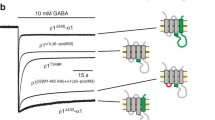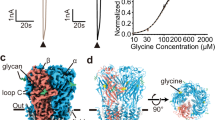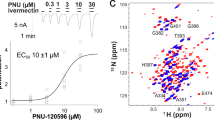Abstract
The cys-loop receptors are neurotransmitter-operated ion channels, which mediate fast synaptic transmission for communication between neurons. However, prolonged exposure to the neurotransmitter drives the receptor to a desensitization state, which plays an important role in shaping synaptic transmission. Much progress has been made through more than half a century’s research since Katz and Thesleff first descried desensitization for muscle nicotinic acetylcholine receptor. In this review, we summarized recent research developments of receptor desensitization. Now, it has been identified that many parts of the receptor, such as the pore domain (including the hinge in the M2–M3 linker), the binding domain, the coupling region, and the intracellular domain, are all involved in the cys-loop receptor desensitization and that uncoupling between the amino-terminal domain and channel lining domain seems to play a central role in desensitization. This uncoupling is mainly governed by the balance between coupling strength and relative tightness of gating machinery and influenced by other parts of the receptor. Agonist binding induces conformational change to overcome the gating barrier to open the channel through the stressed coupling region, which is subsequently broken, causing receptor desensitization. With rapid advancement in structural biology of membrane receptors, final validation of this mechanism is expected to occur in the near future when the high-resolution structure of the desensitized state is available.



Similar content being viewed by others
Reference
Hibbs RE, Gouaux E (2011) Principles of activation and permeation in an anion-selective cys-loop receptor. Nature 474:54–60
Thompson AJ, Lester HA, Lummis SC (2010) The structural basis of function in cys-loop receptors. Q Rev Biophys 43:449–499
Corringer PJ, Baaden M, Bocquet N, Delarue M, Dufresne V, Nury H, Prevost M, Van Renterghem C (2010) Atomic structure and dynamics of pentameric ligand-gated ion channels: new insight from bacterial homologues. J Physiol 588:565–572
Hilf RJ, Dutzler R (2009) A prokaryotic perspective on pentameric ligand-gated ion channel structure. Curr Opin Struct Biol 19:418–424
Miller PS, Smart TG (2010) Binding, activation and modulation of cys-loop receptors. Trends Pharmacol Sci 31:161–174
Beg AA, Jorgensen EM (2003) EXP-1 is an excitatory GABA-gated cation channel. Nat Neurosci 6:1145–1152
Ranganathan R, Cannon SC, Horvitz HR (2000) MOD-1 is a serotonin-gated chloride channel that modulates locomotory behaviour in C. elegans. Nature 408:470–475
Gengs C, Leung HT, Skingsley DR, Iovchev MI, Yin Z, Semenov EP, Burg MG, Hardie RC, Pak WL (2002) The target of Drosophila photoreceptor synaptic transmission is a histamine-gated chloride channel encoded by ort (hclA). J Biol Chem 277:42113–42120
Tasneem Z, Khan MA, Uddin N (2004) Esophageal foreign body in neonates. J Pak Med Assoc 54:159–161
Katz B, Thesleff S (1957) A study of the desensitization produced by acetylcholine at the motor end-plate. J Physiol 138:63–80
Auerbach A, Akk G (1998) Desensitization of mouse nicotinic acetylcholine receptor channels. A two-gate mechanism. J Gen Physiol 112:181–197
Giniatullin R, Nistri A, Yakel J (2005) Desensitization of nicotinic ACh receptors: shaping cholinergic signaling. Trends Neurosci 28:371–378
Chang Y-c WW, J-l Z, Huang Y (2009) Allosteric activation mechanism of the cys-loop receptors. Acta Pharmacol Sin 30:663–672
Hu XQ (2006) An interaction involving an arginine residue in the cytoplasmic domain of the 5-HT3A receptor contributes to receptor desensitization mechanism. J Biol Chem 281:21781–21788
Jones MV, Westbrook GL (1996) The impact of receptor desensitization on fast synaptic transmission. Trends Neurosci 19:96–101
Wang HL, Milone M, Ohno K, Shen XM, Tsujino A, Batocchi AP, Tonali P, Brengman J, Engel AG, Sine SM (1999) Acetylcholine receptor M3 domain: Stereochemical and volume contributions to channel gating. Nat Neurosci 2:226–233
Brownlow S, Webster R, Croxen R, Brydson M, Neville B, Lin JP, Vincent A, Newsom-Davis J, Beeson D (2001) Acetylcholine receptor delta subunit mutations underlie a fast-channel myasthenic syndrome and arthrogryposis multiplex congenita. J Clin Invest 108:125–130
Lobitz N, Gisselmann G, Hatt H, Wetzel CH (2001) A single amino-acid in the TM1 domain is an important determinant of the desensitization kinetics of recombinant human and guinea pig alpha-homomeric 5-hydroxytryptamine type 3 receptors. Mol Pharmacol 59:844–851
Boyd ND (1987) Two distinct kinetic phases of desensitization of acetylcholine receptors of clonal rat PC12 cells. J Physiol 389:45–67
Wang H, Sun X (2005) Desensitized nicotinic receptors in brain. Brain Res Rev 48:420–437
Fenster CP, Beckman ML, Parker JC, Sheffield EB, Whitworth TL, Quick MW, Lester RA (1999) Regulation of alpha4beta2 nicotinic receptor desensitization by calcium and protein kinase C. Mol Pharmacol 55:432–443
Huganir RL, Greengard P (1990) Regulation of neurotransmitter receptor desensitization by protein phosphorylation. Neuron 5:555–567
Pietila K, Ahtee L (2000) Chronic nicotine administration in the drinking water affects the striatal dopamine in mice. Pharmacol Biochem Behav 66:95–103
Bocquet N, Nury H, Baaden M, Le Poupon C, Changeux JP, Delarue M, Corringer PJ (2009) X-ray structure of a pentameric ligand-gated ion channel in an apparently open conformation. Nature 457:111–114
Hilf RJ, Dutzler R (2009) Structure of a potentially open state of a proton-activated pentameric ligand-gated ion channel. Nature 457:115–118
Hilf RJ, Dutzler R (2008) X-ray structure of a prokaryotic pentameric ligand-gated ion channel. Nature 452:375–379
Miyazawa A, Fujiyoshi Y, Unwin N (2003) Structure and gating mechanism of the acetylcholine receptor pore. Nature 423:949–955
Monod J, Wyman J, Changeux JP (1965) On the nature of allosteric transitions: a plausible model. J Mol Biol 12:88–118
Orth G, Vielle F, Changeux JP (1967) On the arginase of the Shope papillomas. Virology 31:729–732
Koshland DE Jr, Nemethy G, Filmer D (1966) Comparison of experimental binding data and theoretical models in proteins containing subunits. Biochemistry 5:365–385
Zhang J, Xue F, Whiteaker P, Li C, Wu W, Shen B, Huang Y, Lukas RJ, Chang Y (2011) Desensitization of 7 nicotinic receptor is governed by coupling strength relative to gate tightness. J Biol Chem 286:25331–25340
Auerbach A (2010) The gating isomerization of neuromuscular acetylcholine receptors. J Physiol 588:573–586
Lape R, Colquhoun D, Sivilotti LG (2008) On the nature of partial agonism in the nicotinic receptor superfamily. Nature 454:722–727
Corradi J, Gumilar F, Bouzat C (2009) Single-channel kinetic analysis for activation and desensitization of homomeric 5-HT(3)A receptors. Biophys J 97:1335–1345
Mukhtasimova N, Lee WY, Wang HL, Sine SM (2009) Detection and trapping of intermediate states priming nicotinic receptor channel opening. Nature 459:451–454
Scheller M, Forman SA (2002) Coupled and uncoupled gating and desensitization effects by pore domain mutations in GABA(A) receptors. J Neurosci 22:8411–8421
Haas KF, Macdonald RL (1999) GABAA receptor subunit gamma2 and delta subtypes confer unique kinetic properties on recombinant GABAA receptor currents in mouse fibroblasts. J Physiol 514(Pt 1):27–45
Li X, Pearce RA (2000) Effects of halothane on GABA(A) receptor kinetics: evidence for slowed agonist unbinding. J Neurosci 20:899–907
Bianchi MT, Macdonald RL (2001) Mutation of the 9’ leucine in the GABA(A) receptor gamma2L subunit produces an apparent decrease in desensitization by stabilizing open states without altering desensitized states. Neuropharmacology 41:737–744
Bouzat C, Bartos M, Corradi J, Sine SM (2008) The interface between extracellular and transmembrane domains of homomeric cys-loop receptors governs open-channel lifetime and rate of desensitization. J Neurosci 28:7808–7819
Solt K, Ruesch D, Forman SA, Davies PA, Raines DE (2007) Differential effects of serotonin and dopamine on human 5-HT3A receptor kinetics: interpretation within an allosteric kinetic model. J Neurosci 27:13151–13160
Shelley C, Cull-Candy SG (2010) Desensitization and models of receptor-channel activation. J Physiol 588:1395–1397
Cachelin AB, Colquhoun D (1989) Desensitization of the acetylcholine receptor of frog end-plates measured in a Vaseline-gap voltage clamp. J Physiol 415:159–188
Franke C, Parnas H, Hovav G, Dudel J (1993) A molecular scheme for the reaction between acetylcholine and nicotinic channels. Biophys J 64:339–356
Chang Y, Ghansah E, Chen Y, Ye J, Weiss DS (2002) Desensitization mechanism of GABA receptors revealed by single oocyte binding and receptor function. J Neurosci 22:7982–7990
Auerbach A (2003) Life at the top: the transition state of AChR gating. Sci STKE 2003(188):re11
Cymes GD, Grosman C (2008) Pore-opening mechanism of the nicotinic acetylcholine receptor evinced by proton transfer. Nat Struct Mol Biol 15:389–396
Rayes D, De Rosa MJ, Sine SM, Bouzat C (2009) Number and locations of agonist binding sites required to activate homomeric cys-loop receptors. J Neurosci 29:6022–6032
Unwin N (2005) Refined structure of the nicotinic acetylcholine receptor at 4A resolution. J Mol Biol 346:967–989
Kash TL, Jenkins A, Kelley JC, Trudell JR, Harrison NL (2003) Coupling of agonist binding to channel gating in the GABA(A) receptor. Nature 421:272–275
Bouzat C, Gumilar F, Spitzmaul G, Wang HL, Rayes D, Hansen SB, Taylor P, Sine SM (2004) Coupling of agonist binding to channel gating in an ACh-binding protein linked to an ion channel. Nature 430:896–900
Chakrapani S, Bailey TD, Auerbach A (2004) Gating dynamics of the acetylcholine receptor extracellular domain. J Gen Physiol 123:341–356
Lee WY, Sine SM (2005) Principal pathway coupling agonist binding to channel gating in nicotinic receptors. Nature 438:243–247
Lummis SC, Beene DL, Lee LW, Lester HA, Broadhurst RW, Dougherty DA (2005) Cis-trans isomerization at a proline opens the pore of a neurotransmitter-gated ion channel. Nature 438:248–252
Castillo M, Mulet J, Bernal JA, Criado M, Sala F, Sala S (2006) Improved gating of a chimeric alpha7-5HT3A receptor upon mutations at the M2-M3 extracellular loop. FEBS Lett 580:256–260
Mercado J, Czajkowski C (2006) Charged residues in the alpha1 and beta2 pre-M1 regions involved in GABAA receptor activation. J Neurosci 26:2031–2040
Lynch JW, Rajendra S, Pierce KD, Handford CA, Barry PH, Schofield PR (1997) Identification of intracellular and extracellular domains mediating signal transduction in the inhibitory glycine receptor chloride channel. EMBO J 16:110–120
Lewis TM, Sivilotti LG, Colquhoun D, Gardiner RM, Schoepfer R, Rees M (1998) Properties of human glycine receptors containing the hyperekplexia mutation alpha1(K276E), expressed in Xenopus oocytes. J Physiol 507(Pt 1):25–40
Finer-Moore J, Stroud RM (1984) Amphipathic analysis and possible formation of the ion channel in an acetylcholine receptor. Proc Natl Acad Sci U S A 81:155–159
Yakel J (2010) Advances and hold-ups in the study of structure, function and regulation of cys-loop ligand-gated ion channels and receptors. J Physiol 588:555–556
Peters JA, Cooper MA, Carland JE, Livesey MR, Hales TG, Lambert JJ (2010) Novel structural determinants of single channel conductance and ion selectivity in 5-hydroxytryptamine type 3 and nicotinic acetylcholine receptors. J Physiol 588:587–596
Kracun S, Harkness PC, Gibb AJ, Millar NS (2008) Influence of the M3-M4 intracellular domain upon nicotinic acetylcholine receptor assembly, targeting and function. Br J Pharmacol 153:1474–1484
Kelley SP, Dunlop JI, Kirkness EF, Lambert JJ, Peters JA (2003) A cytoplasmic region determines single-channel conductance in 5-HT3 receptors. Nature 424:321–324
Reeves DC (2005) A role for the 1–2 loop in the gating of 5-HT3 receptors. J Neurosci 25:9358–9366
Jansen M, Bali M, Akabas MH (2008) Modular design of cys-loop ligand-gated ion channels: functional 5-HT3 and GABA rho1 receptors lacking the large cytoplasmic M3M4 loop. J Gen Physiol 131:137–146
Livesey MR, Cooper MA, Deeb TZ, Carland JE, Kozuska J, Hales TG, Lambert JJ, Peters JA (2008) Structural determinants of Ca2+ permeability and conduction in the human 5-hydroxytryptamine type 3A receptor. J Biol Chem 283:19301–19313
Karlin A (2002) Emerging structure of the nicotinic acetylcholine receptors. Nat Rev Neurosci 3:102–114
Purohit Y, Grosman C (2006) Block of muscle nicotinic receptors by choline suggests that the activation and desensitization gates act as distinct molecular entities. J Gen Physiol 127:703–717
Ulens C, Hogg RC, Celie PH, Bertrand D, Tsetlin V, Smit AB, Sixma TK (2006) Structural determinants of selective alpha-conotoxin binding to a nicotinic acetylcholine receptor homolog AChBP. Proc Natl Acad Sci U S A 103:3615–3620
Revah F, Bertrand D, Galzi JL, Devillers-Thiery A, Mulle C, Hussy N, Bertrand S, Ballivet M, Changeux JP (1991) Mutations in the channel domain alter desensitization of a neuronal nicotinic receptor. Nature 353:846–849
Yakel JL, Lagrutta A, Adelman JP, North RA (1993) Single amino acid substitution affects desensitization of the 5-hydroxytryptamine type 3 receptor expressed in Xenopus oocytes. Proc Natl Acad Sci U S A 90:5030–5033
Chang Y, Weiss DS (1998) Substitutions of the highly conserved M2 leucine create spontaneously opening rho1 gamma-aminobutyric acid receptors. Mol Pharmacol 53:511–523
Chang Y, Weiss DS (1999) Channel opening locks agonist onto the GABAC receptor. Nat Neurosci 2:219–225
Chang Y, Weiss DS (1999) Allosteric activation mechanism of the alpha 1 beta 2 gamma 2 gamma-aminobutyric acid type A receptor revealed by mutation of the conserved M2 leucine. Biophys J 77:2542–2551
Xiu X, Hanek AP, Wang J, Lester HA, Dougherty DA (2005) A unified view of the role of electrostatic interactions in modulating the gating of cys loop receptors. J Biol Chem 280:41655–41666
Sala F, Mulet J, Sala S, Gerber S, Criado M (2005) Charged amino acids of the N-terminal domain are involved in coupling binding and gating in alpha7 nicotinic receptors. J Biol Chem 280:6642–6647
Engblom AC, Carlson BX, Olsen RW, Schousboe A, Kristiansen U (2002) Point mutation in the first transmembrane region of the beta 2 subunit of the gamma–aminobutyric acid type A receptor alters desensitization kinetics of gamma–aminobutyric acid- and anesthetic-induced channel gating. J Biol Chem 277:17438–17447
Bianchi MT, Haas KF, Macdonald RL (2001) Structural determinants of fast desensitization and desensitization-deactivation coupling in GABAa receptors. J Neurosci 21:1127–1136
Lu L, Huang Y (1998) Separate domains for desensitization of GABA rho 1 and beta 2 subunits expressed in Xenopus oocytes. J Membr Biol 164:115–124
McCormack TJ, Melis C, Colon J, Gay EA, Mike A, Karoly R, Lamb PW, Molteni C, Yakel JL (2010) Rapid desensitization of the rat alpha7 nAChR is facilitated by the presence of a proline residue in the outer beta-sheet. J Physiol 588:4415–4429
Yakel JL (2010) Gating of nicotinic ACh receptors: latest insights into ligand binding and function. J Physiol 588:597–602
Bohler S, Gay S, Bertrand S, Corringer PJ, Edelstein SJ, Changeux JP, Bertrand D (2001) Desensitization of neuronal nicotinic acetylcholine receptors conferred by N-terminal segments of the beta 2 subunit. Biochemistry 40:2066–2074
Lynch JW (2004) Molecular structure and function of the glycine receptor chloride channel. Physiol Rev 84:1051–1095
Saul B, Kuner T, Sobetzko D, Brune W, Hanefeld F, Meinck HM, Becker CM (1999) Novel GLRA1 missense mutation (P250T) in dominant hyperekplexia defines an intracellular determinant of glycine receptor channel gating. J Neurosci 19:869–877
Breitinger HG, Villmann C, Becker K, Becker CM (2001) Opposing effects of molecular volume and charge at the hyperekplexia site alpha 1(P250) govern glycine receptor activation and desensitization. J Biol Chem 276:29657–29663
Hu XQ, Sun H, Peoples RW, Hong R, Zhang L (2006) An interaction involving an arginine residue in the cytoplasmic domain of the 5-HT3A receptor contributes to receptor desensitization mechanism. J Biol Chem 281:21781–21788
Ilegems E, Pick H, Deluz C, Kellenberger S, Vogel H (2005) Ligand binding transmits conformational changes across the membrane-spanning region to the intracellular side of the 5-HT3 serotonin receptor. ChemBioChem 6:2180–2185
Acknowledgments
This work was supported by grants from the National Natural Science Foundation of China (31100767, 31271136), Beijing Natural Science Foundation (KZ201210025020), and the National Basic Research Program of China (973 Program) (2012CB722407). We also thank Dr. Yongchang Chang from Barrow Neurological Institute, St. Joseph’s Hospital and Medical Center, (Phoenix, AZ, USA) for his help in proofreading the manuscript.
Conflict of interest
The authors declare that they have no conflict of interest.
Author information
Authors and Affiliations
Corresponding author
Rights and permissions
About this article
Cite this article
Zhang, J., Xue, F., Liu, Y. et al. The Structural Mechanism of the Cys-Loop Receptor Desensitization. Mol Neurobiol 48, 97–108 (2013). https://doi.org/10.1007/s12035-013-8420-z
Received:
Accepted:
Published:
Issue Date:
DOI: https://doi.org/10.1007/s12035-013-8420-z




